Ko Nishino
Single-Shot Shape and Reflectance with Spatial Polarization Multiplexing
Apr 17, 2025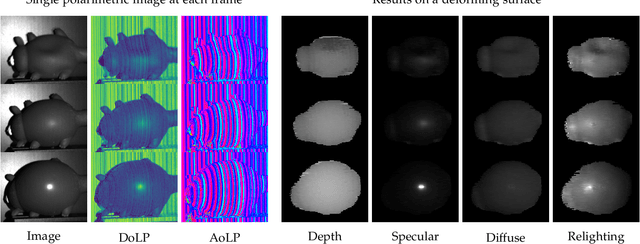

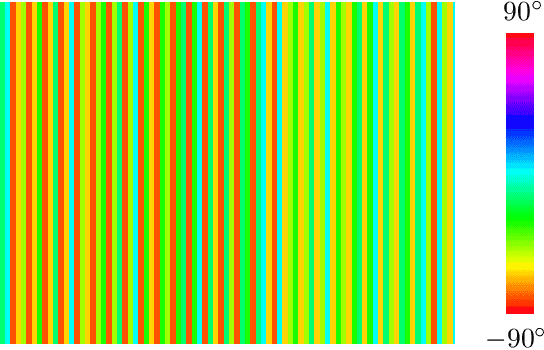
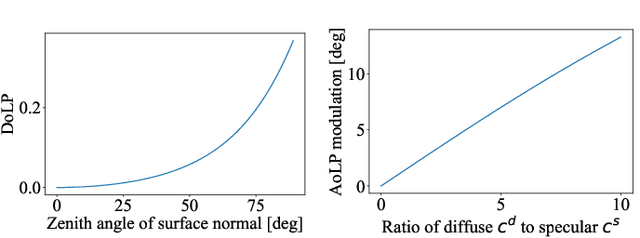
Abstract:We propose spatial polarization multiplexing (SPM) for reconstructing object shape and reflectance from a single polarimetric image and demonstrate its application to dynamic surface recovery. Although single-pattern structured light enables single-shot shape reconstruction, the reflectance is challenging to recover due to the lack of angular sampling of incident light and the entanglement of the projected pattern and the surface color texture. We design a spatially multiplexed pattern of polarization that can be robustly and uniquely decoded for shape reconstruction by quantizing the AoLP values. At the same time, our spatial-multiplexing enables single-shot ellipsometry of linear polarization by projecting differently polarized light within a local region, which separates the specular and diffuse reflections for BRDF estimation. We achieve this spatial polarization multiplexing with a constrained de Bruijn sequence. Unlike single-pattern structured light with intensity and color, our polarization pattern is invisible to the naked eye and retains the natural surface appearance which is essential for accurate appearance modeling and also interaction with people. We experimentally validate our method on real data. The results show that our method can recover the shape, the Mueller matrix, and the BRDF from a single-shot polarimetric image. We also demonstrate the application of our method to dynamic surfaces.
SHeaP: Self-Supervised Head Geometry Predictor Learned via 2D Gaussians
Apr 16, 2025Abstract:Accurate, real-time 3D reconstruction of human heads from monocular images and videos underlies numerous visual applications. As 3D ground truth data is hard to come by at scale, previous methods have sought to learn from abundant 2D videos in a self-supervised manner. Typically, this involves the use of differentiable mesh rendering, which is effective but faces limitations. To improve on this, we propose SHeaP (Self-supervised Head Geometry Predictor Learned via 2D Gaussians). Given a source image, we predict a 3DMM mesh and a set of Gaussians that are rigged to this mesh. We then reanimate this rigged head avatar to match a target frame, and backpropagate photometric losses to both the 3DMM and Gaussian prediction networks. We find that using Gaussians for rendering substantially improves the effectiveness of this self-supervised approach. Training solely on 2D data, our method surpasses existing self-supervised approaches in geometric evaluations on the NoW benchmark for neutral faces and a new benchmark for non-neutral expressions. Our method also produces highly expressive meshes, outperforming state-of-the-art in emotion classification.
Spatiotemporal Multi-Camera Calibration using Freely Moving People
Feb 18, 2025



Abstract:We propose a novel method for spatiotemporal multi-camera calibration using freely moving people in multiview videos. Since calibrating multiple cameras and finding matches across their views are inherently interdependent, performing both in a unified framework poses a significant challenge. We address these issues as a single registration problem of matching two sets of 3D points, leveraging human motion in dynamic multi-person scenes. To this end, we utilize 3D human poses obtained from an off-the-shelf monocular 3D human pose estimator and transform them into 3D points on a unit sphere, to solve the rotation, time offset, and the association alternatingly. We employ a probabilistic approach that can jointly solve both problems of aligning spatiotemporal data and establishing correspondences through soft assignment between two views. The translation is determined by applying coplanarity constraints. The pairwise registration results are integrated into a multiview setup, and then a nonlinear optimization method is used to improve the accuracy of the camera poses, temporal offsets, and multi-person associations. Extensive experiments on synthetic and real data demonstrate the effectiveness and flexibility of the proposed method as a practical marker-free calibration tool.
RatBodyFormer: Rodent Body Surface from Keypoints
Dec 12, 2024Abstract:Rat behavior modeling goes to the heart of many scientific studies, yet the textureless body surface evades automatic analysis as it literally has no keypoints that detectors can find. The movement of the body surface, however, is a rich source of information for deciphering the rat behavior. We introduce two key contributions to automatically recover densely 3D sampled rat body surface points, passively. The first is RatDome, a novel multi-camera system for rat behavior capture, and a large-scale dataset captured with it that consists of pairs of 3D keypoints and 3D body surface points. The second is RatBodyFormer, a novel network to transform detected keypoints to 3D body surface points. RatBodyFormer is agnostic to the exact locations of the 3D body surface points in the training data and is trained with masked-learning. We experimentally validate our framework with a number of real-world experiments. Our results collectively serve as a novel foundation for automated rat behavior analysis and will likely have far-reaching implications for biomedical and neuroscientific research.
MAtCha Gaussians: Atlas of Charts for High-Quality Geometry and Photorealism From Sparse Views
Dec 09, 2024



Abstract:We present a novel appearance model that simultaneously realizes explicit high-quality 3D surface mesh recovery and photorealistic novel view synthesis from sparse view samples. Our key idea is to model the underlying scene geometry Mesh as an Atlas of Charts which we render with 2D Gaussian surfels (MAtCha Gaussians). MAtCha distills high-frequency scene surface details from an off-the-shelf monocular depth estimator and refines it through Gaussian surfel rendering. The Gaussian surfels are attached to the charts on the fly, satisfying photorealism of neural volumetric rendering and crisp geometry of a mesh model, i.e., two seemingly contradicting goals in a single model. At the core of MAtCha lies a novel neural deformation model and a structure loss that preserve the fine surface details distilled from learned monocular depths while addressing their fundamental scale ambiguities. Results of extensive experimental validation demonstrate MAtCha's state-of-the-art quality of surface reconstruction and photorealism on-par with top contenders but with dramatic reduction in the number of input views and computational time. We believe MAtCha will serve as a foundational tool for any visual application in vision, graphics, and robotics that require explicit geometry in addition to photorealism. Our project page is the following: https://anttwo.github.io/matcha/
HeatFormer: A Neural Optimizer for Multiview Human Mesh Recovery
Dec 05, 2024
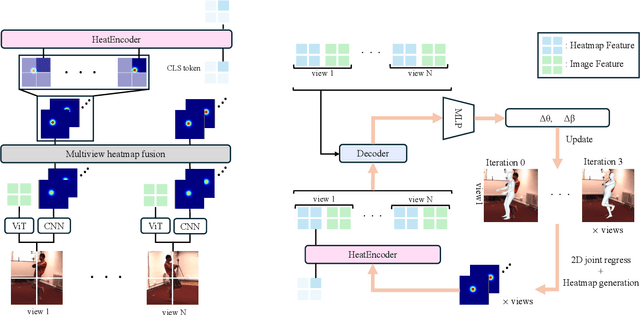
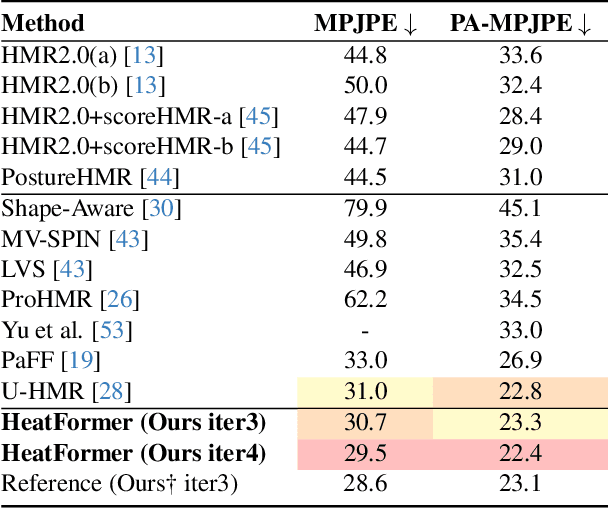
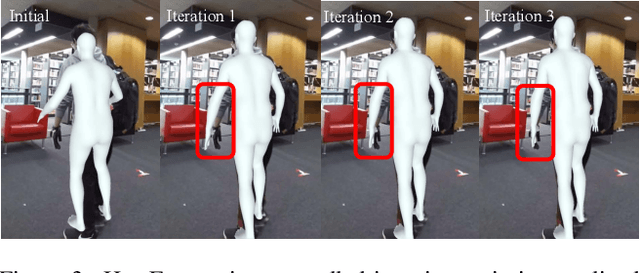
Abstract:We introduce a novel method for human shape and pose recovery that can fully leverage multiple static views. We target fixed-multiview people monitoring, including elderly care and safety monitoring, in which calibrated cameras can be installed at the corners of a room or an open space but whose configuration may vary depending on the environment. Our key idea is to formulate it as neural optimization. We achieve this with HeatFormer, a neural optimizer that iteratively refines the SMPL parameters given multiview images, which is fundamentally agonistic to the configuration of views. HeatFormer realizes this SMPL parameter estimation as heat map generation and alignment with a novel transformer encoder and decoder. We demonstrate the effectiveness of HeatFormer including its accuracy, robustness to occlusion, and generalizability through an extensive set of experiments. We believe HeatFormer can serve a key role in passive human behavior modeling.
PBDyG: Position Based Dynamic Gaussians for Motion-Aware Clothed Human Avatars
Dec 05, 2024



Abstract:This paper introduces a novel clothed human model that can be learned from multiview RGB videos, with a particular emphasis on recovering physically accurate body and cloth movements. Our method, Position Based Dynamic Gaussians (PBDyG), realizes ``movement-dependent'' cloth deformation via physical simulation, rather than merely relying on ``pose-dependent'' rigid transformations. We model the clothed human holistically but with two distinct physical entities in contact: clothing modeled as 3D Gaussians, which are attached to a skinned SMPL body that follows the movement of the person in the input videos. The articulation of the SMPL body also drives physically-based simulation of the clothes' Gaussians to transform the avatar to novel poses. In order to run position based dynamics simulation, physical properties including mass and material stiffness are estimated from the RGB videos through Dynamic 3D Gaussian Splatting. Experiments demonstrate that our method not only accurately reproduces appearance but also enables the reconstruction of avatars wearing highly deformable garments, such as skirts or coats, which have been challenging to reconstruct using existing methods.
KFD-NeRF: Rethinking Dynamic NeRF with Kalman Filter
Jul 18, 2024
Abstract:We introduce KFD-NeRF, a novel dynamic neural radiance field integrated with an efficient and high-quality motion reconstruction framework based on Kalman filtering. Our key idea is to model the dynamic radiance field as a dynamic system whose temporally varying states are estimated based on two sources of knowledge: observations and predictions. We introduce a novel plug-in Kalman filter guided deformation field that enables accurate deformation estimation from scene observations and predictions. We use a shallow Multi-Layer Perceptron (MLP) for observations and model the motion as locally linear to calculate predictions with motion equations. To further enhance the performance of the observation MLP, we introduce regularization in the canonical space to facilitate the network's ability to learn warping for different frames. Additionally, we employ an efficient tri-plane representation for encoding the canonical space, which has been experimentally demonstrated to converge quickly with high quality. This enables us to use a shallower observation MLP, consisting of just two layers in our implementation. We conduct experiments on synthetic and real data and compare with past dynamic NeRF methods. Our KFD-NeRF demonstrates similar or even superior rendering performance within comparable computational time and achieves state-of-the-art view synthesis performance with thorough training.
Multistable Shape from Shading Emerges from Patch Diffusion
May 23, 2024Abstract:Models for monocular shape reconstruction of surfaces with diffuse reflection -- shape from shading -- ought to produce distributions of outputs, because there are fundamental mathematical ambiguities of both continuous (e.g., bas-relief) and discrete (e.g., convex/concave) varieties which are also experienced by humans. Yet, the outputs of current models are limited to point estimates or tight distributions around single modes, which prevent them from capturing these effects. We introduce a model that reconstructs a multimodal distribution of shapes from a single shading image, which aligns with the human experience of multistable perception. We train a small denoising diffusion process to generate surface normal fields from $16\times 16$ patches of synthetic images of everyday 3D objects. We deploy this model patch-wise at multiple scales, with guidance from inter-patch shape consistency constraints. Despite its relatively small parameter count and predominantly bottom-up structure, we show that multistable shape explanations emerge from this model for ''ambiguous'' test images that humans experience as being multistable. At the same time, the model produces veridical shape estimates for object-like images that include distinctive occluding contours and appear less ambiguous. This may inspire new architectures for stochastic 3D shape perception that are more efficient and better aligned with human experience.
Diffusion Reflectance Map: Single-Image Stochastic Inverse Rendering of Illumination and Reflectance
Dec 07, 2023Abstract:Reflectance bounds the frequency spectrum of illumination in the object appearance. In this paper, we introduce the first stochastic inverse rendering method, which recovers the full frequency spectrum of an illumination jointly with the object reflectance from a single image. Our key idea is to solve this blind inverse problem in the reflectance map, an appearance representation invariant to the underlying geometry, by learning to reverse the image formation with a novel diffusion model which we refer to as the Diffusion Reflectance Map Network (DRMNet). Given an observed reflectance map converted and completed from the single input image, DRMNet generates a reflectance map corresponding to a perfect mirror sphere while jointly estimating the reflectance. The forward process can be understood as gradually filtering a natural illumination with lower and lower frequency reflectance and additive Gaussian noise. DRMNet learns to invert this process with two subnetworks, IllNet and RefNet, which work in concert towards this joint estimation. The network is trained on an extensive synthetic dataset and is demonstrated to generalize to real images, showing state-of-the-art accuracy on established datasets.
 Add to Chrome
Add to Chrome Add to Firefox
Add to Firefox Add to Edge
Add to Edge